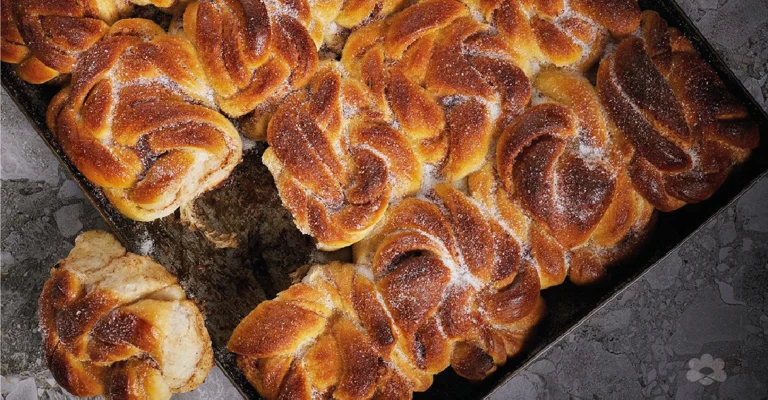


The simple answer is don’t skip on properly greasing your oven proof dish, otherwise there’s a high chance of the buns sticking while baking. Using waxed oven paper is also extra helpful.
While both a metal and a glass dish will work just fine, the glass will retain heat better and also avoids the risk of the buns reacting with the metal to alter their flavor.
If not enough air gets into the dough during the kneading and rising process the result will be a flat, lifeless bun. Make sure the yeast you use hasn’t expired, and as a guide check the dough has doubled in size from when it was first mixed until it is ready to be put in the oven. Other factors that can prevent the yeast from activating properly include being baked in a cold room or the liquid added to it being too hot.
It can be tempting to roll the buns until they’re tight, but the goal is to allow enough room for the layers to expand and bake evenly through to the middle. Try to achieve a balance between rolling gently but not too loose.
There is definitely such a thing as too much kneading. Doing so makes the flour tough and ruins the end product. Only knead the dough until it is smooth, shiny and elastic.
The modern Swedish variety of cinnamon rolls featured in this recipe has its origins in the 1920s. When items rationed during the First World War finally came back in stock, ingredients like butter, sugar, flour and cinnamon became hot commodities. People were drawn to cafés where they could once more order a cinnamon rolls with their coffee, and bakeries started taking orders for the treats. The popularity of the sweet treats grew rapidly from there.
A common feature of the variety of cinnamon rolls sold in the US is cream cheese frosting, and combining that topping with the Swedish classic creates a mouth-watering alternative. Simply mix cream cheese, butter, sugar and powdered cinnamon until fully blended. Once you have a smooth and fluffy consistency, add it to the top of the warm cinnamon rolls and serve.
Once the rolls have been allowed to cool at room temperature, they can be frozen, defrosted then later quickly re-heated at a low temperature to soften up. It can also be a good idea to wait until defrosting before adding the sugar and butter topping to create the freshest flavor possible.

Fall in love with pasta all over again, as you serve your loved ones creamy dishes made richer with Puck—and your special touch. Our inspiring recipes, general guidelines, and detailed articles will set you on the path to culinary creativity. With Puck’s entire range of cooking creams and sauces that meet your high standards, you’ll love putting your personal spin on pasta.